Wind and Repeats
Wednesday, August 13, 2008
 Limnos, Greece
Limnos, Greece
Samothraki
The last episode of our exciting (yaaaaaawn, zzzzzzz) adventures left us sitting out bad weather in Kamariotissa on Samothraki . This lasted for another couple of days during which time we read , walked a bit, sewed a bit (new hatch covers, and mossie screens if your interested) and got the bus to the lovely village of Hora.
To get there one has to get a bus or pay an extortionate amount for a run down 50cc scooter. We decided to get the bus. Regular readers of this blog will, of course, remember that the Greeks have cunning ways of not letting one know where buses go from, where they go to and when they go! However, one can tell that Samothraki was a Turkish Island until the 1920s because they publish a bus timetable and have an area where buses seem to congregate and socialise - nae problem! The bus turned up 10 minutes early and then proceeded to remain empty, except for us and a few other visitors, until 17 minutes after the published departure time. The driver got on board along with the conductor, the engine started, the doors were closing and suddenly about 20 Samothrakians turned up, ambling across to the bus without a care in the world, got on and then we departed up through the hills to Hora - brinksmanship or what!
Hora is the traditional capital of Samothraki island . It is beautifully situated in a hanging valley on the side of Mount Fengari, - at 1611metres (5000+feet) the highest island mountain in The Aegean. The village rests under a ruined Genoese castle and really is quite lovely in a rugged, masculine sort of way. If it took human shape it would be a tall, tanned man with grey hair, a large manly sort of moustache, smoking an evil-smelling old pipe wearing a battered trilby with a rock on it (bear with us on this one - all will shortly become clear). However, one would probably find that he was wearing gold lame`underwear and keeps his pipe in a Prada pipe bag for, whilst there is no tweeness in it's structure, it's shops, have a decidedly northern European feel to them and prices to match. One can buy hand painted glassware at London prices (Gina did), Greek made cotton traditional/fashionable clothing at Paris prices and the usual tat including pretty little painted models of wooden trawlers of a Northern European design but with a Greek flag on them at twice the price one would pay in Blackpool, Everywhere in Greece they have these bloody boats on sale . Why? - the Greek fishing boats are really picturesque with their lovely double ender hulls, flared bows, huge spade rudder, long tiller, scruffy canvas sunshades and stunning paintwork, yet all they sell are painted models of North Sea trawlers - yea OK, rant over!
That is the down side to the village. The up sides are the rugged beauty of it's houses (it is so windy here that they have very heavy tiles on their roofs and then put rocks on the tiles to hold them down - thus the reference to the rock on the hat), the mountain and sea views, the Ottoman fountains with permanently running water from the mountain streams and the ruins of the once glorious and arrogant castle above the village.
Back to Limnos again
The departure from Samothraki saw us rising at some ungodly hour to the wind howling round the boat. This was a step in the right direction, previously it had been shrieking or screaming, so we knew that the weather was improving and decided to leave. For the first hour we were sailing on a downwind sleigh ride, surfing down the short steep seas with only a scrap of sail set . Then, as we got about 4 miles from the island, the wind lessened, we put full sail up and were immediately caught in a nasty cross sea with waves coming from 2 directions at once. The wind and one set of waves took us on course and then another set of waves slammed into us at right angles. Very uncomfortable, but not dangerous. As we got further from this draughty island the wind lessened further, the seas calmed down and the bloody sun poured down loadsa degrees onto us - it got very hot. After about 4 hours sailing we then had to motor sail the next 4 hours to Mirina on Limnos.
We managed to moor up on the quay and get water and electricity - civilisation at last. The harbour was pretty empty but started to fill as the evening and night rolled on.
At 5 PM on a lazy Sunday afternoon we were relaxing in the cockpit with a beer or two. The quay was jam packed when a Greek yacht appeared and the skipper asked if he could squeeze his boat in beside us (there was a half metre gap between us and the next boat) if he could persuade the other boats to move up a little . We agreed, thinking he would never manage it. On board he had a male mate, three bikini clad Greek beauties and, we later discovered, very few fenders. Using persuasive skills and charm of a high order, he managed to get about 8 boats to shift and created a not quite adequate space. As he backed into the gap he gave each of the women on his boat a fender each and backed into the gap. This left one fender on the entire boat. The gap was tight yet he managed (quite skilfully) to get the boat in. However, ourselves and the yacht on the other side of him (a pleasant Greek family from Thessaloniki) had to deploy every fender we had to keep his hull from damaging ours and, at the point of contact, the fenders were squeezed paper thin. At least the skipper had the good grace to apologise - but only once his boat was firmly tied to the quay - smarmy bastard!
After this incident dinner was our next priority. We got a couple of pides (Greek pizzas) from the fridge only to find them unusable. Rob went out for a take-away and, on his return the rain started to piss down and the wind howl . Hatches were battened, everything on deck was brought below, tempers were lost and dinner was, eventually, eaten. All in all it was a really laid back Sunday - NOT!
By Tuesday we knew that the wind was set strong for the week so resigned ourselves to staying her a while longer. To pass the time we hired a small motorbike and explored the island for a day.
The main object of out travels was to head for Ifestia to see a recently restored theatre and other remains of a 2600 year old community. En route Gina started feeling unwell and faint (a condition not to be taken lightly when riding pillion!) so we stopped at the village of Kondias for a coffee and a coke. Kondias is an attractive but workmanlike agricultural village/town. Some of the houses seem to be made in a unique design from dark grey stone. They give the place a slightly sombre feel.
After a can of coke and a chat with an old boy who shared our table (and had excellent English)Gina had recovered and was her usual ebullient self. We set off again on our travels and came across a first world war allied war cemetery at Portianou . As usual it was immaculately kept and an infinitely sad place. At the entrance were pictures and newspaper cuttings about of 2 of the occupants that had been left, we assume, by visiting relatives. Both had died of dysentery. As we browsed the gravestones we noticed that, whilst the occupants came from all over the British Commonwealth and beyond, there were a lot of graves of those who served with the Royal Army Medical Corps, many of whom were conscientious objectors who nonetheless risked life and limb to help the wounded. The saddest, perhaps, were the graves of two women, a nursing sister and matron. They had obviously come to Limnos to serve in the hospitals on the island and had succumbed to the various infections that must have been rife on this boggy, damp and very hot island with so many sick and wounded.
After leaving this sad place we headed towards the ancient sites of Limnos and enjoyed the very different landscapes here. They reminded us of the Scottish moorland. There was plenty of bog, lakes, rushes and hillocks . The villages that we passed through were all working agricultural communities rather than the picture-postcard white and blue Greek townscapes that we had become familiar with in the islands.
Ifestia is an ancient community dating back beyond 600 BC. A team of Italian archaeologists has excavated an ancient theatre and community which started way back when and was enhanced by the Romans and their successors and then forgotten about. It is situated on the side of a hill in a drop-dead-gorgeous bay with deep red algae growing on it's fringes and impossibly white salt-pans in the distance. It can only be reached by a long ride along a dirt track. However, it is well worth the trip. The site is well presented with proper paths and informative interpretation.
After hacking back down the dirt track we had lunch in our favourite taverna in Moudhros (the best home made chips in Greece) and left feeling absolutely stuffed yet having spent only €15.00.
By the by, for any of you contemplating coming to Limnos at some point, make sure you try the Limniot wines. They really are superb, especially the whites - you have been told!
We now expect to sit here until the week-end when the weather is supposed to calm down enough to give us a comfortable sail the 60 miles back to Lesvos.
Other Entries

 Limnos, Greece
Limnos, Greece
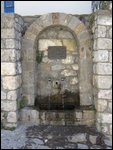

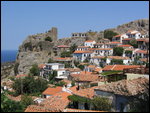

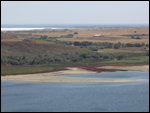
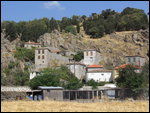
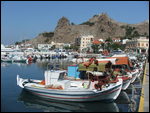





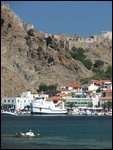
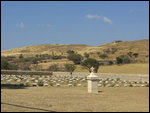
2025-05-22